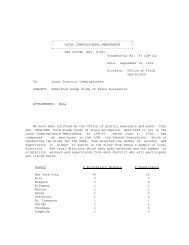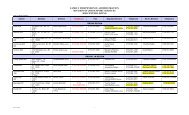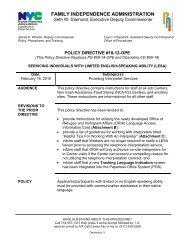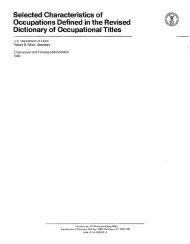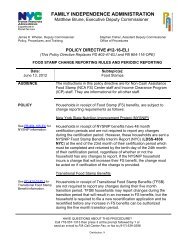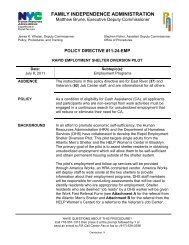Family Health Plus Premium Assistance Program - Online Resource ...
Family Health Plus Premium Assistance Program - Online Resource ...
Family Health Plus Premium Assistance Program - Online Resource ...
Create successful ePaper yourself
Turn your PDF publications into a flip-book with our unique Google optimized e-Paper software.
A: Yes, although they have no premium payment, they can benefit from the copayments<br />
and deductibles being reimbursed to them. The plan must also be deemed<br />
qualified.<br />
35. Q: In Section (a) of the FHP-PAP Cost Effective Calculator, question #2:<br />
“Does the employer policy include the Optional/Non-Benchmark required<br />
services listed in Column A, lines 2a through 2e?” If the answer is "No", there are<br />
instructions on how to proceed; however, there are no instructions for the "YES"<br />
option. Does one skip to Section B? What is the next logical step?<br />
A: If "no" the regional cost of the service is added to the cost of the ESI and<br />
compared to the FH<strong>Plus</strong> managed care rate. If the answer is “Yes”, the plan does cover<br />
the optional benefits, do not enter a cost. Skip to section B.<br />
36. Q: When the family includes FH<strong>Plus</strong> eligible parents and non-Medicaid<br />
children over the age of 6, should the children be included in the FHP-PAP cost<br />
effectiveness calculation?<br />
A: No, the children would not be included in the case count, but you would use the<br />
family premium to see if it is cost effective to pay the family premium. If not cost<br />
effective to pay the family premium, then do a cost effectiveness for just the parents, if<br />
the premium is different for the parents.<br />
37. Q: If non-Medicaid eligible children are on the family policy, will Medicaid<br />
pay the deductibles, coinsurance and co-pays for the children?<br />
A: The parents would pay the children’s deductibles and co-pays. They would not be<br />
reimbursed for costs associated with non-Medicaid eligible children.<br />
38. Q: What should the district do if it is determined cost effective to pay the<br />
family plan insurance and the children are on CH<strong>Plus</strong>?<br />
A: If the children are enrolled in the ESI policy, the district should notify the CH<strong>Plus</strong><br />
plan of the child’s insurance.<br />
39. Q: If there are CH<strong>Plus</strong> children in the household, should they be considered<br />
when doing the cost effective calculation?<br />
A: Only costs for expanded Medicaid eligible children and FH<strong>Plus</strong> adults should be<br />
included in the FHP-PAP cost effective determination. If it is cost effective to pay for a<br />
family policy, CH<strong>Plus</strong> eligible children can be added to the ESI policy.<br />
40. Q: If a household contains FH<strong>Plus</strong> eligible parents and CH<strong>Plus</strong> eligible<br />
children, should the children enroll in the ESI?<br />
A: If the policy is a family policy (not just a “couples” policy) and it is cost effective,<br />
the district should encourage the parents to enroll the children in that policy. The district<br />
should notify the CH<strong>Plus</strong> plan of this enrollment.<br />
41. Q: Will the parents be reimbursed for coinsurance, deductibles or copayments<br />
made on behalf of the CH<strong>Plus</strong> children?<br />
A: The parents will not be reimbursed for those costs.<br />
42. Q: Can the parents refuse to enroll the children in ESI in order to avoid<br />
paying coinsurance, deductibles and co-payments?<br />
A: We cannot force non-applying children to be added to the policy. If the children are<br />
enrolled in the ESI, the CH<strong>Plus</strong> plan should be notified. The districts may call the<br />
6



